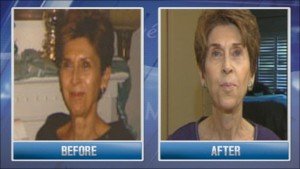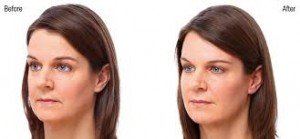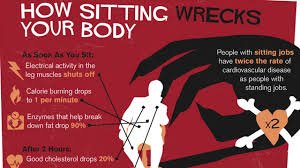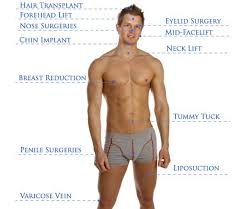Vitamin D is essential for bone health, but that doesn’t mean you have to risk the effects of sun damage just to get your daily dose. UV rays can cause premature aging of the skin and skin cancer, whereas dietary sources of Vitamin D don’t.
Your body must have vitamin D to absorb calcium and promote bone growth. Too little vitamin D results in soft bones in children (rickets) and fragile, misshapen bones in adults (osteomalacia). You also need vitamin D for other important body functions.
Vitamin D deficiency has now been linked to breast cancer, colon cancer, prostate cancer, heart disease, depression, weight gain, and other maladies. These studies show that people with higher levels of vitamin D have a lower risk of disease, although they do not definitively prove that lack of vitamin D causes disease — or that vitamin D supplements would lower risk.
DALLAS — Sixty-nine-year-old Ruth McKinnon works hard to keep her body in shape, but her lean face is the work of Father Time.
“I’ve lost the volume, and it makes me look much older than what I actually feel,” she said.
Cheek volume loss is natural as people age. A new cosmetic filler called Voluma was FDA-approved in October to temporarily plump up cheeks.
North Texas physicians are now beginning to use the product.
“A facelift will lift loose skin or loose muscle, but it doesn’t really add volume unless you add something to it,” explained Dallas dermatologist Dr. Lori Stetler.
She said Voluma is FDA-approved for the mid-face, and should not be used on the lips.
Voluma is made with hyaluronic acid gel, polysaccharide sugar that occurs naturally in the body. According to the Juvéderm website, “the most common side effects include temporary reactions at the treatment site such as tenderness, swelling, firmness, lumps/bumps, bruising, pain, redness, discoloration, and itching.”
As with all skin-injection procedures, there is also a risk of infection. Because the product requires a deep injection, it contains the anesthetic lidocain. Patients with an allergy to lidocaine should not use Voluma.
Results can be seen immediately after side-effects dissipate (not all patients experience side-effects).
Experts say most patients will need two or more syringes per treatment.
The product is designed to last for two years, longer than other fillers. That’s appealing to Jessica George, who just turned 40.
With a full-time job and two busy kids, she doesn’t have extra time to spend getting cosmetic treatments.
“I want natural,” George said. “I just want to look more youthful, get a few of those years back.”
Voluma has another advantage: It’s reversible.
“It’s dissolvable, so if for some reason you have a problem with it — the patient doesn’t like it, you end up with a little bump — you can put a little enzyme in to dissolve it, you’re done,” Dr. Stetler said. “Some of the other permanent fillers, you’re stuck with them.”
If a mistake is made with other products, patients must either wait for it to wear out with time or sometimes suffer long-lasting consequences.
“I was astonished at the difference,” Ruth McKinnon said. “It actually filled in the hollow area that I focused on every time I looked in the mirror.”
McKinnon underwent two treatments. Doctors say it’s better to under-estimate the amount of product needed at first, rather than overfill.
While McKinnon doesn’t want any extra plumpness on her body, she likes what a little extra volume does to her face.
This News brought to you courtesy of WFAA.
Voluma is now available in the office of Dr. Mark Bishara and The Paragon Plastic Surgery & Med Spa in Mansfield and Southlake, TX
What Are Hair Loss Treatments
If you’re experiencing any type of hair loss, see your doctor so that it is accurately assessed and properly treated. There are a number of hair-loss treatment options available to address different types of hair loss.
Hair-loss treatments may include any of the following:
- Topical Treatments
- Prescription Pills
- Hair Restoration Surgery
Hair Transplants
A hair transplant is a surgical procedure in which hair follicles are removed from a donor site and transplanted onto areas where hair loss is occurring. One type of hair transplant surgery is called follicular unit extraction (FUE), which is a tedious and time-consuming process, in which the doctor has to harvest and remove follicles from hairy parts of the head and body, then punch out the tiny hair follicles needed for the transplant. The process also involves having to guess where the follicle lives—slicing the wrong location can lose the follicle forever. An older, tried-and-true method, known as the strip technique, involves removing a strip of hair and separating it into smaller units for the transplant. The drawback to this method is that it can sometimes leave a scar on the back of the head and it usually requires more recovery time.
Improving on FUE
By the age of 50, approximately 50 percent of all men experience some degree of hair loss. Prescription remedies can offer some benefits to existing hair, but hair restoration is the only permanent solution for hair loss and often achieves a natural, undetectable result.
FUE offers less discomfort and a faster return to normal daily activities than traditional, more invasive methods of hair restoration. Performed in Dr. Bishara’s office, FUE with ARTAS moves healthy, functioning follicles to the areas of the patient’s scalp most impacted by baldness for more dramatic results. The implanted hairs develop their own blood supply, begin to grow and new hairs are seen a few months after the procedure has taken place. New hair continues to grow over the course of a full year, making the change in the patient’s appearance gradually noticeable to others. Healing time is short, and there is no resultant linear scar as happens with other methods of hair restoration. The only evidence is tiny, white scars left in the donor area, which are the same as those produced by manual FUE.
Dr. Mark Bishara is proud to offer a wide range of comprehensive hair restoration procedures. Combined with his extensive experience and advanced skills, these procedures are often highly effective. The best treatment option for each patient depends on the location and extent of hair loss. Dr. Bishara will take the time to evaluate each patient, discuss his/her individual goals and together develop a personalized treatment plan using one of his many successful hair loss treatment options. Please call our office for more information at 817-473-2120 or visit our website at www.MarkBisharaMD.com.
The Effects Lifestyle has on Your Body
It’s been scientifically shown that sitting at a desk all day (more than 6 hours) is linked to weight gain, especially in the stomach. We spend more time than ever working and that comes along with prolonged sitting. Constant sitting decrease the acitivity of the fat-burning enzyme lipoprotein lipase (they live in the fat cells), which is necessary for weight loss.
Your risk of heart disease has increased by up to 64 percent. You’re shaving off seven years of quality life. You’re also more at risk for certain types of cancer. Simply put, sitting is killing you.
Also, a lack of inactivity during the day can cause blood sugar and cortisol (the stress hormone) levels to rise, which leads to sugar and food cravings.

What You Can Do:
Sitting all day long isn’t hard to counteract, but you have to keep your eye on two details: your daily activity and the amount of time you sit.
If you are stuck behind a desk for most of the day, happily, you only need to do two things to counter the effects of sitting all day:P
- Remember to stand once an hour.
- Get about 30 minutes of activity per day.
This News is brought to You Courtesy of Dr. Mark Bishara and The Paragon Plastic Surgery & Med Spa
Background
Although men do not face the same hormonal changes with aging that women do, the male biological clock still ticks, and over time changes in a man’s appearance can lead to a negative self-image, which can take a toll on mental and physical health. Today, men are turning to cosmetic surgery in an effort to help break the cycle of interaction between appearance and negative self-image. Because of this emerging trend, more male patients will be asking their trusted primary care providers for advice in navigating the potentially treacherous world of cosmetic surgery.
Whether in the public eye or leading a more private life, many men put forth energy, effort, and income to maintain a healthy, youthful appearance. Increasing access to more affordable, innovative, and less invasive forms of cosmetic surgery has resulted in more men turning to cosmetic procedures in an effort to look and feel younger. In fact, the American Society of Plastic Surgeons 2010 Report of Plastic Surgery Statistics indicates that of the 12.6 million plastic surgery procedures conducted annually, over 1.1 million were performed on men — a dramatic increase from the 225,009 procedures performed on men in 2000. Demonstrating their cost-effectiveness in these challenging economic times, minimally invasive procedures, such as botulinum toxin injections (Botox) and fillers, were up more than 9% from the prior year in 2010-2011. The more costly operative procedures that men undergo in large numbers include robotic hair transplants, nose reshaping (rhinoplasty), liposuction, cosmetic eyelid surgery (blepharoplasty), and facelifts, as well as surgery to correct male breast enlargement (mastopexy).
The ideal cosmetic plan maintains a life-stage balance of facial and body appearance that allows one to look their best throughout adult life. At earlier stages in life, avoiding excessive sun exposure, toxins from smoking, and recreational drug use will help to stall the progression of environmentally related aging changes. Later, avoiding significant weight fluctuation minimizes the development of loose or flabby skin. Body issues unrelated to such lifestyle factors as diet and exercise are best addressed once bone and soft tissues have reached maturity. For some, a time may come when surgery is considered for body issues unrelated to lifestyle, and plastic surgery may be the best option to help maintain a healthy self-image.
When selecting a plastic surgeon, patients should be sure to consider expertise and board certification. It is important to do the research and be patient with the selection process, because it can take some time. Patients should consider the procedure carefully and discuss with the surgeon whether a procedure is the right step to help meet their goals; this is an important part of the process because cosmetic surgery is not the answer for everyone. Patients should consult with their physician so that they can ask the correct questions in order to move forward appropriately.
A plastic surgeon will help identify patients whose body image goals and objectives may not be met with an operation alone. Postponing surgery with referral to a nutritionist, exercise trainer, or internist may be the appropriate outcome of the initial consultation. For surgery that is entirely elective, all patients should be close to their ideal health before having an operative procedure. If lifestyle choices and habits are not addressed preoperatively, the results of most cosmetic surgeries will be transient and therefore ultimately not worthwhile.
The following is a guide to help men look and feel their best throughout the lifespan.
Men in Their 30s
A man’s circulating testosterone level begins to decrease after age 30 years, with loss of lean muscle mass averaging 1% a year. Because of this, the most important thing a man can do to keep himself looking youthful is to continue building and maintaining his muscle mass. A regular program of cardiovascular fitness paired with weight training is essential to mitigate the natural aging process of decreased muscle mass. Proper hydration and attention to rest and diet are reflected in a healthier, more youthful appearance.
At this stage, age-maintenance procedures that are less invasive and are cost-effective can deliver results that look far more natural than other, more radical surgical choices. Skin care, sun avoidance, and proper use of sunblock are also crucial at this and every life stage.
Men in Their 40s
The use of botulinum toxin injection (Botox) and fillers has become much more common among men in their 40s and 50s, who are beginning to deal with the loss of facial skin elasticity. Because a man’s face has a more robust blood supply than a woman’s face, surgeons performing any personal enhancement treatments on the face must consider such factors as the depth of skin peeling, energy levels for light base treatments, and frequency of past use of topical medications.
The most common aesthetic procedure for men in this age group involves rejuvenation around the eyes. Blepharoplasty (eyelid surgery), when done well, can help revitalize a man’s face in a discreet manner, without announcing to the world that a cosmetic procedure was performed.
Men in Their 50s and Beyond
Regardless of age, encourage your patients to take a planned, realistic, and conservative approach to achieving their ideal body image. Less favorable cosmetic surgery outcomes among men, such as those seen in Bruce Jenner, Mickey Rourke, and Burt Reynolds, can and should be avoided with the guidance and support of surgeons who demonstrate a clear understanding of what cosmetic surgery options are available, along with knowledge of overarching health concerns.
At the office of Dr. Mark Bishara and The Paragon Plastic Surgery & Med Spa, we provide a wide range of cosmetic procedures to help patients look and feel their best. These procedures are designed to improve the appearance of the face and body through minimally invasive techniques that provide highly effective results. Many of these procedures can be combined in order to achieve your desired appearance. Please call our office to find out more about us at (817) 473-2120 or visit our website at www.MarkBisharaMD.com.












